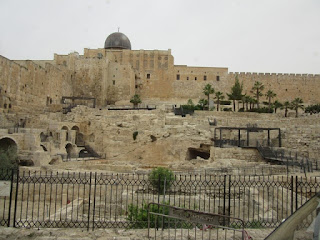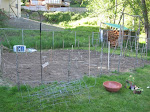Excavation began in 1968 and it uncovered around 50 ritual baths (mikvehs) that pilgrims would use before ascending the steps. Large cisterns and jars to hold all the water needed were also found.
Once they were clean, pilgrims would ascend the 200-foot wide staircase to the Hulda gates. The stairs were uneven, some wide and some narrow. It is believed that the 15 wide steps were stopping points on which to recite one of the Psalms of Ascent.
the Hulda Gates are now bricked shut
It is amazing how big the stones of the wall are!
These steps are also known as the "Teaching Steps" because rabbis would sit here and teach their disciples. Many scholars also believe this is the place where the Church was born in Acts 2. It was near the "house" of God and a good place where over 3000 people could hear Peter's sermon.
When Neil Armstrong visited the Southern Steps, a very likely place where Jesus walked many times, he said, "I am more excited stepping on these stones than I was stepping on the moon."
At the corner of the Western Wall is where the priests would blow the shofar. At the top corner a stone was found that had "to the place of trumpeting" engraved into it. It is believed it was to indicate to the builders were this specially carved stone was to go.
Also along the start of the Western Wall, was a 1st century street about 35-feet wide and paved with large stones about a foot thick. It was flanked by shops. Much of the street was broken up by the large stones that were pushed off the Mount by Roman soldiers during the destruction of the Temple.
Then we went back through the Dung Gate to the bus.






























No comments:
Post a Comment